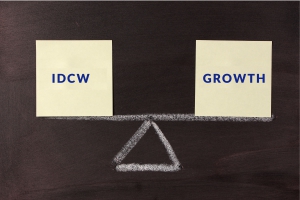In a world full of choices, confusion invariably always shows up. Whether you are buying a mansion, a carton of milk, or investing in mutual funds in India, the decision of what to choose may be perplexing. Mutual funds also offer various options for investing your money as well as receiving your returns. The latter can be done in two ways – the first is with the growth option, and the second with the IDCW option. Before you go ahead and start investing, here are some things to know about each to solve the IDCW vs growth discourse.
What is IDCW in mutual fund schemes?
Income Distribution cum Capital Withdrawal or IDCW pays back some part of the capital gains or dividends to you depending on the profits made by the mutual fund scheme. So, you earn a regular flow of income through this option.
Now that we have the answer to “What is IDCW in mutual funds?”, let’s move on to the growth option.
What is the growth option in mutual fund schemes?
The growth option is the opposite of the IDCW plan. Under this option, the fund house reinvests the dividends received or profits earned from the underlying securities to earn more. You can only receive money when you redeem your units. If not, the money continues to be invested in the stock market and other securities.
IDCW vs Growth: Differences explained
Here are some differences between IDCW and growth mutual funds:
- Net Asset Value (NAV):
In the case of IDCW funds, once the Asset Management Company (AMC) has paid the investors, the fund’s Net Asset Value (NAV) is reduced by the amount given to investors. On the contrary, the NAV continues to grow in growth funds.
- Returns:
The IDCW gives the dividends and profits to the investors instead of reinvesting them into the market. Hence, the overall returns may be relatively lower. Growth mutual fund schemes invest the dividends and profits back into the market and may generate a higher overall return in comparison because of the power of compounding.
- Tax:
The returns from an IDCW plan are taxed as regular income according to your applicable income tax slab. On the other hand, returns from growth funds are taxed as long-term and short-term capital gains when redeemed.
IDCW vs growth mutual fund: Wondering what to choose? Let’s make it easy for you.
IDCW plans may be ideal for you if you wish to receive a steady flow of income to meet your regular needs. Alternatively, a growth plan can be suitable if you wish to invest for the long term, especially when investing in equity funds. Since the profits and dividends get reinvested, the ultimate return is higher over a long investment horizon.
Conclusion
Just as there are different mutual fund types and different modes of investing in mutual fund schemes, there are also multiple ways to receive your returns. Understanding each can help you plan for your expenses well and create a suitable withdrawal strategy. Now that you have an idea about IDCW vs growth mutual fund, you can make better investment decisions.
An investor education initiative by Edelweiss Mutual Fund
All Mutual Fund Investors have to go through a onetime KYC process. Investor should deal only with Registered Mutual Fund (RMF). For more info on KYC, RMF and procedure to lodge/redress any complaints, visit - https://www.edelweissmf.com/kyc-norms
MUTUAL FUND INVESTMENTS ARE SUBJECT TO MARKET RISKS, READ ALL SCHEME RELATEDDOCUMENTS CAREFULLY
Trending Articles
MUTUAL FUND INVESTMENTS ARE SUBJECT TO MARKET RISKS, READ ALL SCHEME RELATED DOCUMENTS CAREFULLY.




















